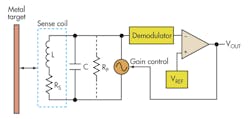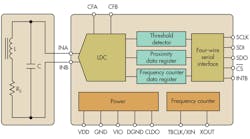The technology of inductive sensing has been around for decades. It’s utilized extensively in industrial automation as a means for counting gear teeth or accurately measuring distance to a metal surface without contact.
Related Articles
- Industrial Environments Require Rugged Design
- The Quest For Zero Power Logic
- Automotive Communications Demand A Robust Infrastructure
Historically, this technique has required complex circuitry, making it costly for applications outside of industrial controls or portable metal detectors. With new integrated solutions now available, though, inductive techniques can be applied to a far wider range of applications.
Introduction
Walter Pepperl and Ludwig Fuchs first employed inductive sensing in 1958 in Mannheim, Germany. They wanted to find a technology to replace mechanical contacts that would wear out in hostile environments or were simply dangerous in explosive atmospheres due to arching.
This file type includes high resolution graphics and schematics when applicable.
The basic principle of inductive sensing remains the same as Pepper & Fuchs’ original design. It is based on an inductor-capacitor (LC) tank circuit pumped by an oscillator where the inductor is made from a sensing coil. As a conductive metal object is brought near the coil, eddy currents form in the object as a function of the distance, the material, and the size of the object.
The eddy currents form an opposing magnetic field that has the effect of reducing the oscillation amplitude. This has the apparent effect of changing the equivalent parallel resonance impedance (RP) of the tank circuit:
RP = L/RSC
L is the coil inductance in henrys, RS is the coil series resistance in ohms, and C is the parallel capacitance in farads. This change in the apparent parallel resistance is measured in these systems to determine distance to the target. It can be measured in several ways.
One method is to place a demodulator following the tank and digitizing the resultant dc value. As RP changes, the amplitude of the tank diminishes. However, this scheme limits the system’s dynamic range and is only useful for switching applications (metal object detected or not).
A superior method is to follow the demodulator with a closed-loop control system to maintain the LC tank’s oscillation amplitude. As a metal object moves closer to the sense coil, the opposing magnetic field requires more drive current into the tank, which can be accurately measured. This technique provides a wider dynamic range in measuring RP and improves the overall performance (Fig. 1).
Applications
There are many applications for inductive sensing. For example, mechanical buttons can be replaced in machine controls by simply placing a conductive metal slug at the top of each button so it is pressed the distance between the top of the button and the coil degreases. Since the circuitry knows the position of the button, it could even detect how hard (via change in position versus time) the button was pushed. This could be useful for equipment stop switches where an operator may simply want to stop (in the normal shutdown time) a machine or execute a panic stop (which locks the machine immediately). This arrangement could detect both states.
Additionally, in harsh environments where dirt or corrosion would degrade a normal mechanical contact, this inductive proximity button would not be affected. It also can be used for intrusion detection in equipment racks or chassis. By placing the sensor near the door or access panel, the system could measure if it has been opened for security detection or shut down high-power equipment that potentially could be dangerous, all without the wear and corrosion problems of mechanical contacts.
There are far more applications beyond proximity detection for inductive-sensing technology. It can be used to measure rotation for applications such as anti-lock brakes, knobs, or flow-sensing turbines. This can be done by using a round tapered conductive metal target. As it turns over the sense coil, the amount of exposed area changes, allowing a measurement of the angle. By using a ramp-shaped metal target, linear position can be measured for applications such as closed-loop focus control in lenses or seat position in automobiles.
Another use of the same circuitry is to measure coil inductance. If the coil has a variable inductance such as a spring, it can become the sensor (without the use of a target conductive material). For instance, a spring can be used as a simple displacement sensor that already may be present in the system. An application example might be using the springs in a passenger car seat to measure the approximate weight of an occupant—required for determining if an airbag should be deployed in a collision.
This technique of using a spring as a sensor has many additional applications. If the circuitry is sensitive enough, slight changes in the deformation of the spring can be detected. This can be useful in applications such as elder care monitoring to measure respiration rate as a person sleeps. By instrumenting the bed springs, both respiration rate and occupancy can be monitored.
Higher Levels Of Integration
To make all of these applications cost effective, higher levels of system integration are required. New completely integrated inductance-to-digital converters have been introduced, such as the Texas Instruments LDC1000, which have extremely high accuracy and can be used for all of these applications and many more (Fig. 2).
By including the tank oscillator, closed-loop detector, counters, registers, and interface subsystems into a single package, engineers can now use inductive sensing in applications where it was previously too costly. Integration also enables additional applications that have not yet been conceived due to the lower cost and small size. (The TI solution is 4 by 5 mm.)
Applications for highly integrated solutions include game controllers (buttons and joy sticks), flow meters, printers, and musical instruments, as well as numerous automotive uses for seat belt detection, throttle and brake position, door sensors, closed loop seat position controls, and many others.
Conclusion
Inductive sensing technology has been around for more than 50 years and is found in industrial control and manufacturing applications. It can sense distance to a conductive metal target, rotational angle, and linear position as well as measure the compression of a spring.
With the introduction of highly integrated inductance-to-digital converters, many new applications will be possible due to lowered implementation cost and size. Inductive sensing then can move into consumer products and white goods, improving mechanical performance and supporting completely new applications.
This file type includes high resolution graphics and schematics when applicable.
References
For more information about inductive sensing and the inductance-to-digital-converter, visit http://www.ti.com/ldcand http://www.ti.com/product/ldc1000.
Download a data sheet at http://www.ti.com/lit/ds/symlink/ldc1000.pdf.




